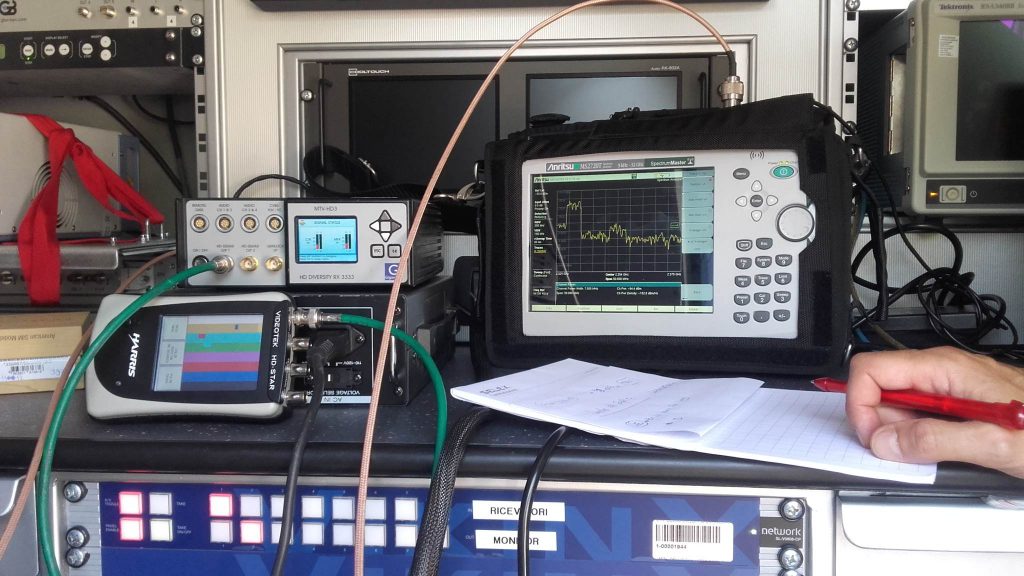Experimentation of the coexistence of PMSE services and LTE in the 2.3-2.4 GHz band
The growing demand for transmission capacity by operators of mobile telephony has led in recent years Governments in evaluating new methods of management of the radio spectrum. In Italy the television operators, including Rai, use for their TV contribution feeds some frequency resources managed by the Ministry of Economic Development (MISE), on occasional basis and in limited areas. One example is the use of wireless cameras (PMSE, Programme Making and Special Events) in the 2.3-2.4 GHz band. To optimize resources, the European Union promotes, in certain frequency bands, the adoption of spectrum sharing, according to different approaches. In particular, in the 2.3 -2.4 GHz band, LSA (Licensed Shared Access) approach would allow additional users (e.g. LTE operators) to use the band provided that they ensure incumbent operators (TV operators), according to appropriate procedures, not to suffer from interference that could jeopardize their normal activity.

Recently, the Italian the Ministry of Economic Development (MISE) with the collaboration of FUB (Ugo Bordoni Foundation) and the Joint Research Center (JRC) of the European Commission, has launched an LSA experimental project. Under this activity, Rai was invited, as a primary user, to participate in a field trial organized by MISE, in order to confirm the adequacy of existing sharing rules (i.e. those listed in ECC Reports 172 [1]) to provide service protection to the incumbent PMSE equipment (wireless cameras) in a hypothetical scenario of band sharing with LTE systems. In the tests [2,3], carried out in the test-bed of EUR district in Rome, it was meant to assess the impact of LTE co-channel interference on the link quality of a PMSE equipment in the “fringe” area. Moreover, we tried to assess the impact of the presence of the LTE user terminals operating on adjacent channels, at various distances from the PMSE receiver.
The experimentation, however, could not explore the most critical “mobile video link” scenario contemplated in the ECC Report 219 [4], i.e., video shooting by aircraft: this case has not been subject of this experimentation for the difficulties of implementation. Anyway, the test campaign allowed to explore a typical shooting scenario.
The collected data include: levels of received and interfering signals in different configurations, measured C/(N + I) ratio, power spectra of signals and video quality. Although the tests have not contemplated the presence of crowds, typical of televised events, and which constitutes an additional variable impacting the link performance, it was possible to obtain useful conclusions regarding the coexistence of the PMSE and LTE services, the management of the latter during the events on the same channel and on adjacent channels, and about the validity of the criteria proposed by ECC Rep. 172 document [1].
The cumulative effect of interference when more than one source of interference (LTE Base Station and/or user terminals) are operational should be investigated in a further analysis.

More information
Authors:
Andrea Bertella, Assunta De Vita, Vittoria Mignone, Davide Milanesio, Bruno Sacco, Mirto Tabone
Collaborations:
- RAI: Arturo Baglioni, Andrea Cafasso, Cristiano Raniolo
- MISE, Centro Nazionale di Controllo Emissioni Radioelettriche (CNCER)
- Fondazione Ugo Bordoni
- Joint Research Center (JRC) of the European Commission
References
[1] ECC-Electronic Communications Committee, Report 172 – Broadband Wireless Systems Usage in 2300-2400 MHz, CEPT 2012
[2] A. Bertella, A. De Vita, V. Mignone, D. Milanesio, B. Sacco, M. Tabone: “Sperimentazione della coesistenza di servizi PMSE e LTE in modalità LSA nella banda 2.3-2.4 GHz: analisi preliminari”, Relazione tecnica CRIT n° 2016/xx, novembre 2016 (in Italian)
[3] A. Baglioni, A. Cafasso, A. De Vita, V. Mignone, D. Milanesio, C. Raniolo, B. Sacco: “Report sui test PMSE-LTE nella banda 2,3-2,4 GHz (Roma, 12-13 settembre 2016)”, Relazione tecnica CRIT n° 2016/xx, novembre 2016. (in Italian)
[4] ECC-Electronic Communications Committee, Report 219 –Characteristics of PMSE digital video links to be used incompatibility and sharing studies, CEPT 2014
Related Projects

Active project
Mitigation techniques of the interference generated in TV distribution installations by 4G/5G signals in the 700 and 800 MHz bands
The activation in the UHF band of 4G/5G Base Stations can have in some areas an impact on TV reception, especially in case of community antenna installations. The adoption of proper interference mitigation techniques, such as the insertion of specifically designed filters at the head-end of the distribution network, allows to mimimise the effects in most situations.

Active project
Laboratory characterization of the antenna performance for a typical LTE-800 device
The characterisation of a typical LTE cellphone embedded antenna has been done, in order to enable the simulations of geographic coverage for a terrestrial television service towards mobile terminals.

Experimental activity (completed)
Experimentation of the coexistence of Radio Link services and LTE in the 3.6-3.7 GHz band
The growing demand for transmission capacity for mobile access has led in recent years public administrations to consider new ways of spectrum management, which include sharing between different services and operators. At the invitation of the Italian Ministry of Economic Development we have participated and contributed to a field experiment aimed at assessing the problems of interference eventually suffered by Fixed Services (Radio Links for TV contribution / distribution) by LTE services in the 3.6-3.7 GHz band.

Active project
Networks and Protocols
The television signal that we can see in our living room, after being generated in a TV studio or in an external shooting site, in order to reach our TV set, makes use of a rather complex and articulated telecommunications network. Broadcasting from the closest TV transmitter represents only the last part of this network.
The “Networks and Protocols” project has the task of studying the transport networks for TV signals from the shooting point up to the transmitters, with the purpose of guiding and accompanying the technological evolution of Rai networks.